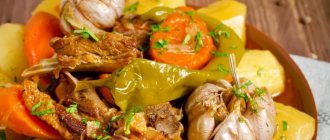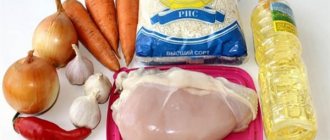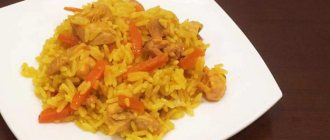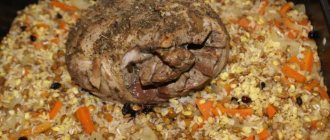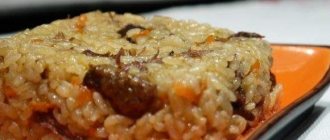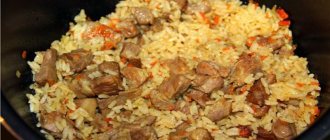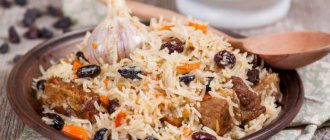3
Prepared by: Dashuta
12/01/2014 Cooking time: 3 hours 0 minutes
| Save | I cooked) | Estimate |
The most delicious and aromatic pilaf is Azerbaijani; if you cook it correctly, it turns out so amazing that all other versions of pilaf simply pale in comparison to it, believe me.
Description of preparation:
Many of us think that the modern simplified version of pilaf is the real and only true one, but this is not at all true.
Therefore, today I propose to recall traditional Azerbaijani cuisine and, in particular, the recipe for preparing Azerbaijani pilaf with lamb. Upon closer examination, it turns out that there is not much in common between the traditional and modern versions: only rice and meat. But there is a significant difference in the method of preparing and serving pilaf, so I suggest you carefully read the recipe for Azerbaijani pilaf with lamb with photos and cook this amazing dish yourself. Purpose: For lunch / For dinner Main ingredient: Meat / Lamb / Cereals / Rice / Long grain rice Dish: Hot dishes / Pilaf Geography of cuisine: Azerbaijani
Shah pilaf in a slow cooker
You have already learned the classic recipe for making Shah Plov. It is not necessary to cook this dish in the oven. Shah pilaf in pita bread in a slow cooker will also turn out excellent. By the way, unlike our interpretation of pilaf, carrots are not added to the Azerbaijani dish. But if you wish, you can add this root vegetable.
Compound:
- 0.7 kg lamb;
- 300 g dogwood, raisins and dried apricots;
- 125 g butter;
- 0.7 kg rice cereal;
- 4 onions;
- barberry, salt, mixture of peppers and turmeric to taste;
- 4 things. garlic cloves.
Preparation:
- Wash the rice grains thoroughly until the water runs clear.
- Soak for a couple of hours.
- Then cook until half cooked in salted water.
- Be sure to add turmeric powder when cooking rice.
- Place the boiled rice in a colander.
- In a multicooker container, sauté the onion in melted butter.
- Then combine it with meat and fry until the lamb is half cooked.
- Pre-soften the dried fruits in a bowl of water.
- Grind dried apricots and barberry berries.
- Cut the pita bread into several equal strips.
- As described in the previous recipe, line the multi-cooker container with pita bread.
- Lubricate with melted butter.
- Lay out the rice and meat filling in layers.
- Add whole peeled garlic cloves.
- Cover the filling with strips of pita bread and pour in the remaining melted butter.
- Select the “Baking” program mode and set the timer for 60 minutes.
- Cook until the beep sounds.
- Carefully, using a steamer stand, remove the pilaf from the multicooker container.
- Cool slightly and divide into portions.
Ingredients:
- Lamb - 1 kilogram (shoulder part without bones)
- Long grain rice - 2 cups
- Onions - 6-8 pieces
- Potatoes – 4 pieces
- Dried apricots – 100 grams
- Raisins – 100 grams
- Butter – 150 grams
- Fresh greens - 80-100 grams (cilantro, parsley)
- Sumac - 1 tbsp. spoon (dried pomegranate)
- Thyme - 0.5 teaspoons
- Turmeric – 0.5 teaspoons
- Olive oil - To taste (for frying)
- Ground black pepper - To taste
- Salt - To taste
Number of servings: 5-6
For pilaf for 4 servings we will need:
- long rice, such as Basmati - 2 cups (at the rate of half a cup of rice per serving)
- ghee - approximately 50-100 grams (can be replaced with regular butter)
- turmeric or saffron (if you can find it) - for color
- salt - to taste
- Rice needs to be washed and soaked in cold water for about 30 minutes. Fill approximately a 3-4 liter pan with water and bring to a boil, not forgetting to add salt well.
You will need a little more salt than usual, because we will then add salt to the water, and it will not be possible to add more salt to the rice.
- When the water boils, add the rice and cook until al dente or until it is slightly undercooked and crunches in your teeth. It will be about 20 minutes, maybe half an hour.
Don’t forget to taste the rice sometimes so you don’t miss this moment, otherwise it won’t work!
- During this time we need to prepare a large colander with small holes, ghee and turmeric. If you don’t have ready-made ghee, you can melt a little butter.
- If you find real saffron (we need it or turmeric for the beautiful yellow color and aroma), you will need a few threads, which need to be poured with a couple of teaspoons of boiling water.
- This infusion (you need to infuse for 30 minutes) then needs to be mixed with oil to pour over the pilaf.
- Well, the rice is almost ready and we carefully pour it along with the water into the prepared dushlag.
- And then the witchcraft begins! The bottom of the pan should be slightly greased with oil.
There you can put dough for gazmakh (I’ll tell you about that too) or pita bread - for a lazy version, coarsely chopped potatoes or sweet pumpkin. All this is then considered a delicacy and served along with pilaf.
- Or you can not put anything, but start carefully laying out the rice, adding ghee and turmeric after every 3-5 centimeter layer. As an experienced housewife, I laid it out in pieces, but the most convenient way is to pour melted water evenly over it.
If you want white pilaf, then we do not add any spices.
- When we have laid out all the rice in this way, put the pan on low heat and cover with a lid, previously wrapped in a kitchen towel. The fabric will absorb all the moisture and make our pilaf crumbly.
- Cook for about another 30 minutes and the rice will become just fluffy, rice to rice! And, of course, incredibly delicious!
How to cook “Azerbaijani pilaf with lamb”
Let's start cooking by preparing the rice; first, rinse it very thoroughly under running water several times until the water after the rice becomes clear.
Now pour water into the pan, add a little salt and bring to a boil. As soon as the liquid boils, put the rice in the pan and mix everything. Cook the rice over low heat for 10 minutes so that it remains a little hard (with cloves).
Place the boiled rice in a colander and rinse under cold water.
Next, we should melt the butter, but so that it does not heat up too much. This can be done in a water bath or in a microwave oven.
Now peel and wash the potatoes.
Cut it into fairly thick slices (0.5 cm) and place it on the bottom of a greased pan so that the rice does not burn.
Mix about half the boiled rice with half the butter and place it in a saucepan on top of the potatoes.
Place the remaining rice on top of this rice, pour the other half of the butter over it and sprinkle with turmeric. Simmer the rice over low heat for an hour, this can be done either on the stove or in the oven (at 180 degrees on the lowest tier).
Next, let's prepare the meat, clean the lamb from films and sinews and cut into small pieces (2-2.5 cm wide). Place the meat in heated olive oil and fry until golden brown.
Lamb should be fried in one layer; if all the meat does not fit at once, it should be fried in parts.
Transfer the fried meat to a clean thick-walled pan or cauldron.
Pour half a glass of water into the frying pan in which the lamb was fried and use a wooden spatula to rub the bottom of the pan so that all the remaining meat is mixed with the liquid. Pour the resulting water into the pan with the fried lamb.
Peel the onions and cut them into half rings.
Place the onion in the pan with the meat and place it over medium heat. As soon as the liquid in the pan boils, reduce the heat to low.
Gently stir the contents of the pan.
Next, rinse under water and chop the fresh herbs.
We spread it with the meat and onions, add thyme and sumac. Mix everything again, cover the pan with a lid and simmer the lamb for 40 minutes, stirring it from time to time.
Now we wash the dried apricots and raisins and pour boiling water over the dried fruits for 10 minutes.
When the meat is ready (after 40 minutes), put the dried fruits in the pan. Cover the pan again with a lid and simmer for another half hour. At the end of cooking, add salt and pepper to taste and let it sit for 10 minutes, covered. Gently mix the top layer of the finished rice so that the turmeric is evenly distributed in it, but so as not to touch the bottom white layer of rice.
Azerbaijani pilaf with lamb is served like this: put rice (both yellow and white) with pieces of potatoes in the middle of the plate, put some meat with onions and dried fruits on the rice, sprinkle the finished dish with fresh herbs and serve. Bon appetit everyone!
Azerbaijani pilaf from Stalik Khankishiev in a cauldron
6. And together with onion juice, he flavored the meat and decorated it. In just 20 minutes it will be an excellent seasoning for pilaf. Do you know in what places on earth the dish “pilaf” was formed? I think I've found a pattern. Here, firstly, Eurasia is divided into a zone where wheat is traditionally grown, where rye is traditionally grown and where rice is traditionally grown. Where they grow a lot of rice, they eat it instead of bread, eat it every day. And rice is even considered the food of the poor. But there is a border between the wheat and rye zone and the rice zone. And in this zone, little rice grows. Well, you don’t eat it every day anymore. You can eat it once a week, or maybe even once a month. Mostly people eat bread. And it was in these places where rice is a relative rarity that the dish “pilaf” was born. Why? Yes, because rice, as a rare product, was supplemented with all the best, the best oil, the best meat, and the best other products. And they traditionally added the best spices, the most expensive spices, cumin in Central Asia, and saffron - this is Azerbaijan, Iran, this is India, in a word, where they are familiar with saffron. In Russia, saffron is not very familiar. Everyone knows the word, but not everyone knows what it looks like. And not everyone knows how to use it either. People always ask me: “Stalik, how to prepare saffron infusion? Stalik, how to prepare saffron infusion? If they tell you how to prepare dill infusion, will you cope with the task? In the same way, you can brew saffron with hot water and let it sit. This is the infusion for you. But saffron is an expensive spice. I take a pinch. And in order to use it sparingly, I put it in a mortar. Saffron threads are quite soft.
You need to take either granulated sugar or coarse salt. And crystals of sugar or salt will help us turn saffron literally into powder. You can take boiling water, or just hot water. Pour a little into the mortar, you don’t need much. They stirred it, and the whole veranda was filled with the wonderful smell of saffron. Look at the snow-white rice we have in the cauldron. And look that now some of the grains of rice are already bending, and now they look like fingers sticking out of a layer of rice. This means that the rice has already dried out enough. But the napkin is damp. Now is the time to drizzle the saffron and butter over the rice. They poured the ring. And now I’ll put some of the rice here, in the mortar. I have some saffron crumbs here. And right here with them. And these grains of rice will turn out completely red. How much oil should you pour on the rice now? If I were now preparing Uzbek pilaf from Uzbek varieties of rice, then I would take, well, maybe 200 grams of butter. This would be more than enough. This amount of basmati requires approximately 300 grams of oil. Now let this butter melt, gradually pass through the rice, envelop every grain of rice. And then we will have pilaf. We need to wait another 10 minutes.
Lavash for pilaf
For Shah pilaf, as you already understood, you need lavash. Of course, you can buy it at any grocery store. However, if you set out to prepare a delicious dish yourself from start to finish, then you may need a homemade pita bread recipe. Thin flatbreads made from unleavened dough are not as difficult to prepare as they might seem at first glance. They are traditionally cooked in the oven, but in modern conditions a non-stick frying pan or even a regular cast iron one will do just fine.
In order to prepare pita bread, you will need approximately 700 g of flour, 300 g of water and salt to taste. Knead the above ingredients into a stiff dough, divide it into parts and roll out each into a very thin (no more than 2 mm thick) flat cake. Fry it in a dry hot frying pan without adding butter.
Stage No. 1. Cooking rice
First, before you start cooking the cereal, soak a few strands of saffron in a cup of boiling water and let it brew for at least one hour.
Washing rice before cooking it is a process that has become almost an axiom for us. In this case, in order to prepare pilaf shakh, you do not need to do this. In a large saucepan, bring a sufficient amount of water to a boil - 2-3 liters, add salt and add dry rice. Cook the cereal until half cooked, this will take about 5-10 minutes. Remember that you are only lightly steaming it, not cooking it. Then drain the rice in a colander.
Stage No. 2. Meat preparation
Meat (chicken, beef, lamb) must first be boiled so that it is soft. This needs to be done within 2-2.5 hours. Quite a long process, so it's better to do it in advance.
Scroll the hot onions through a meat grinder and squeeze the juice dry. In a preheated frying pan with the addition of a small amount of butter, fry it over low heat.
Cooking with milk
Sometimes Azerbaijani pilaf is prepared with the addition of milk. This option will definitely appeal to those who don’t eat meat at all.
To work you will need:
• 0.5 cups rice (round grain); • 250 milliliters of milk; • 70 grams of butter; • 400 milliliters of boiled water; • 1 pita bread; • 60 grams of raisins; • ½ teaspoon of saffron tincture.
In this case, the cooking method will be different:
1. Pour milk and water into a saucepan and heat (but do not boil). 2. Add rice and salt there. Cook until the cereal is ready. 3. Then rinse the rice with hot water, strain and pour it onto a towel to dry for 15 minutes. 4. Soak raisins in boiling water. 5. Treat the inside of the cauldron with oil and cover with lavash. 6. Pour dried rice with raisins into it. Simmer the food covered over low heat for at least 30 minutes. Pour hot oil mixed with saffron tincture over the finished pilaf in a plate.
